Azadi ka Amrit Mahotsav Kolkata event honours four Clergymen
Pope Francis asks businesses to support working women: They’re ‘afraid to get pregnant’
Study: Christianity may lose majority, plurality status in U.S. by 2070
Indian politician declines Magsaysay Award under party pressure
Like John Paul II, Pope Francis heads to Kazakhstan during time of war
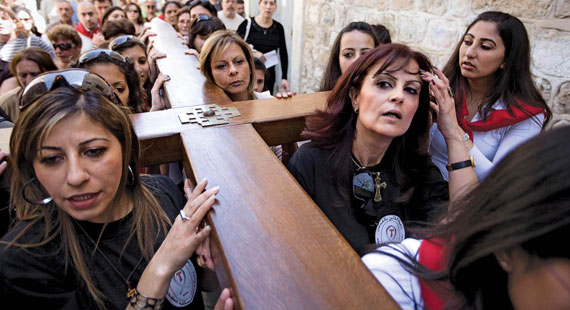
The survey of Catholic Women was conducted by the Centre for Applied Research in the Apostolate (CARA) with The GfK Group (GfK, formerly Knowledge Networks) for America Magazine. Panel members are randomly recruited through probability based sampling, and households are provided with access to the Internet and hardware if needed. For this study, GfK sampled households from its Knowledge Panel to conduct a survey between August 3, 2017 and August 24, 2017. A total of 1,508 women self-identifying as Catholic in the United States completed the survey (in English or Spanish). The margin of sampling error for the overall sample is ±2.5 percentage points. Using survey and Census data, CARA estimates that there are 37.3 million Catholic females in the United States at the time of the survey. Of this population, 28.8 million are adults.
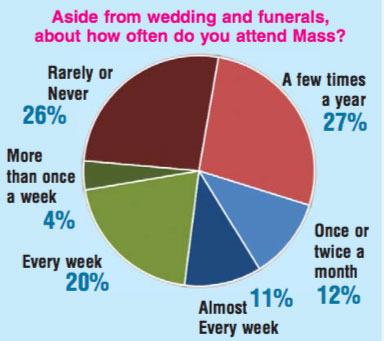 About a quarter of Catholic women in the United States attends Mass once a week or more often (24%). Nearly the same share, 23%, attends Mass less than weekly, but at least once a month. 27% attends a few times a year and 26% attends rarely or never.
About a quarter of Catholic women in the United States attends Mass once a week or more often (24%). Nearly the same share, 23%, attends Mass less than weekly, but at least once a month. 27% attends a few times a year and 26% attends rarely or never.
Millennial (born 1982 or later) and Post-Vatican II Generation (born 1961-81) are less likely than older Catholic women to attend Mass at least once a week. 17% of Millennials and 18% of Post-Vatican II respondents indicated they attend Mass at least once a week compared to 31% of Vatican II respondents (born 1943-60) and 53% of Pre-Vatican II respondents (born before 1943). There are no statistically significant differences for frequency of Mass attendance by education or race and ethnicity. However, married Catholic women are significantly more likely to attend Mass weekly (29%) than those who are divorced or separated (19%), never married (16%), or who are living with a partner (6%).
Seventy Eight percentage of Catholic women believe in God and have no doubts about this. 16% believe and sometimes have doubts and 4% believe but have frequent doubts. Taken together, 98% believe in God, although some with doubts. 2% say they do not believe in God but believe it is possible that God may exist (i.e., agnostic). A small share, 0.4%, are atheists and do not believe in God—although they self-identify as Catholic.
The small share of Catholic women who do not believe in God are more likely than believers to be non-Hispanic white, born after 1960, to be unmarried or living with a partner, and to attend Mass a few times a year or less often.
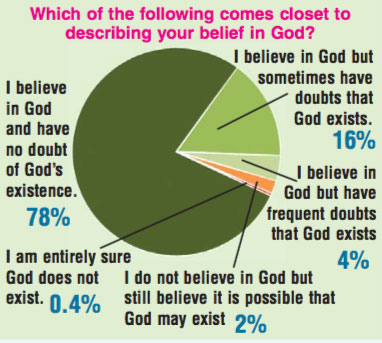
Three in ten Catholic women go to confession at least once a year. Only 3% goes to confession monthly or more often. About a third, 32%, goes to confession less than once a year. Nearly four in ten, 38%, say they “never” go to confession. This is distinct from never having gone to confession. This is unlikely as most would have done so before receiving First Communion. The “never” response to this question is best understood to reflect that this is something they no longer do and do not anticipate doing in the future.
Two-thirds of weekly Mass attenders go to confession at least once a year (66%). About one in ten who go to Mass a few times a year or less often goes to confession at least once a year (9%). Also, Hispanic or Latino women are much more likely than non-Hispanic white women to go to confession at least once a year (41% compared to 22%). Overall, 45% of respondents who think of themselves as practicing Catholics go to confession at least annually.
A majority of Catholic women pray daily (51%). One in five prays less than daily, but at least once a week (20%). Fourteen percentage pray less than weekly, but at least once a month. Fewer than one in ten pray only a few times a year. Seven percentage pray rarely or never. Overall, seven in ten Catholic women agree “somewhat” or “strongly” that “prayer is essential to my faith.”
Respondents who reported they pray at least a few times a year were asked when they were likely to pray. The most common response was during times of crisis (80% “most of the time” or “always”) followed by when they feel blessed (70%). Two-thirds pray this often when they feel anxious or depressed (66%). Majorities pray this often before bed (58%) and during Lent (53%). Respondents were least likely to indicate they pray “most of the time” or “always” before meals (30%).
Respondents who report they pray at least a few times a year were also asked about what they do while they pray. Most often, Catholic women are praying for the wellbeing of their family (84% “most of the time” or “always”). They also are likely to pray this frequently for the wellbeing of other non-family members they know (69%) or they are simply talking with God (69%). Sixty-three percentage pray most of the time or more often by saying a specific Catholic prayer. Six in ten pray this frequently for their own wellbeing (60%). They are less likely to be participating in religious devotions this frequently (21%).
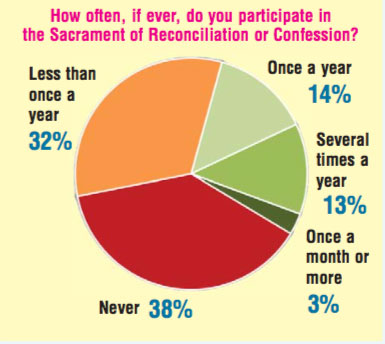 Thirteen percentage of Catholic women say they participate in Eucharistic Adoration on a regular basis. Twelve percentage participate in prayer groups. The same share say they regularly participate in religious retreats. Twelve percentage also say they participate in Bible study or Lectio Divina. Fewer than one in ten regularly participate in pilgrimages (8%). Seventy-one percentage of Catholic women say they do not participate in any form of group prayer (i.e., outside of attending Mass). Fifteen percentage of Catholic women have served as a catechist or religious education teacher in a parish Fewer than one in ten have served in other roles.
Thirteen percentage of Catholic women say they participate in Eucharistic Adoration on a regular basis. Twelve percentage participate in prayer groups. The same share say they regularly participate in religious retreats. Twelve percentage also say they participate in Bible study or Lectio Divina. Fewer than one in ten regularly participate in pilgrimages (8%). Seventy-one percentage of Catholic women say they do not participate in any form of group prayer (i.e., outside of attending Mass). Fifteen percentage of Catholic women have served as a catechist or religious education teacher in a parish Fewer than one in ten have served in other roles.
Have you served in any of these ministries in a Catholic parish?
Sixty Seven percentage of Catholic women have not served a parish in any of the ministry roles they were asked about. Respondents are least likely to be involved in young adult ministry (4%), as an RCIA team member or sponsor (4%), or as an usher or minister of hospitality (4%). One in 20 have been an altar server (5%).
Helping the poor and receiving Communion are the most important to respondents’ “sense of what it means to be Catholic” (45% “very much”). Less important are being involved with their parish (18%) or going to confession regularly (20%).
Catholic women are more likely to agree “very much” that divorced and remarried Catholics (25%) and non-heterosexual Catholics (25%) are welcome in their parish than unwed Catholic parents (16%). Fewer than a quarter agree “very much” that their parish has ministries to help widows deal with the loss of a spouse (22%) or that their parish provides support for new mothers (19%). Only 18% agree “very much” that women are involved in the decision-making of their parish (a majority, 53%, agrees “somewhat” or “very much” with this statement).
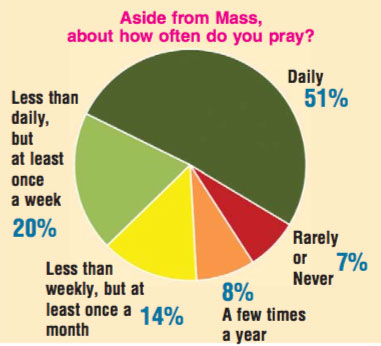 The more frequently Catholic women attend Mass, the more likely they are to agree “very much” that women are involved in the decision-making of their parish (11% among those attending a few times a year or less often compared to 32% attending weekly or more often). Hispanic women are slightly more likely than non-Hispanic women to agree “very much” with the statement (23% compared to 15%). There are no statistically significant differences by generation.
The more frequently Catholic women attend Mass, the more likely they are to agree “very much” that women are involved in the decision-making of their parish (11% among those attending a few times a year or less often compared to 32% attending weekly or more often). Hispanic women are slightly more likely than non-Hispanic women to agree “very much” with the statement (23% compared to 15%). There are no statistically significant differences by generation.
About half of Catholic women, 49%, “agree strongly” with the statement “I am proud to be Catholic.” One in five “agree somewhat” (19%). Thus, collectively, 68% of Catholic women agree that they are proud to be Catholic. A quarter neither agrees not disagrees. Seven percentage disagree with the statement (4% “somewhat” and 3% “strongly”).
The Catholic women most likely to “agree strongly” that they are proud to be Catholic include: weekly Mass attenders (84%), the Pre-Vatican II Generation (75%), and those who agree strongly that they think of themselves as practicing Catholics (75%). Those least likely to “agree strongly” include: those attending Mass a few times a year or less often (30%) and those who disagree that they think of themselves as a practicing Catholic (11%).
Respondents were asked if they ever considered leaving Catholicism. Overall, 82% of Catholic women had not considered this.
When asked “briefly indicate why you left,” respondents who had considered leaving were able to describe, in their own words, their reasons. These responses were categorized, coded, and counted. The most common reasons were related to some disagreement with the Catholic Church’s stance on a particular issue (39%) followed by being attracted to another faith or religion (23%). Fifteen percentage cited an issue with their local parish, 9% cited “hypocrisy” of the Church or its members, and 7% cited the clergy sex abuse scandal. One in five (21%) provided a reason that did not fit these categories or that could be combined with other similar responses.
As noted previously, all respondents self-identify their religion as Catholic. Those who had noted that they left for a time were asked, “Briefly indicate why you returned.” Thirty-five percentage indicated they had not returned to the Church even though they self-identify as Catholic. Seventeen percentage indicate they felt a call or sought to return to the faith they were raised in. Sixteen percentage note their return was related to family. Thirteen percentage cited a need for spiritual fulfilment. Nine percentage indicated they had come to feel more positive about Catholicism. Seven percentage cited a change in their local parish community as bringing them back. One in ten cited some other reason that could not be classified with other responses.
Respondents were asked, “Where do you get your ideas/models of being a woman in the Catholic Church from?” They could respond in their own words. The most common role models were family, parents, or friends (38%) followed by religious education in the Church (33%) and by the Bible, saints, God, scripture, and other readings (19%). Fewer note the influence of women religious (9%), no one in particular (9%), their own religious beliefs (8%), or simply being raised Catholic (5%). Seven percentage noted some “other” influence that could not be combined with other categories.
Twelve percentage of respondents indicate that they have considered becoming a religious sister or nun. This is equivalent to 3.5 million adult women who self-identify as Catholic in the United States today.
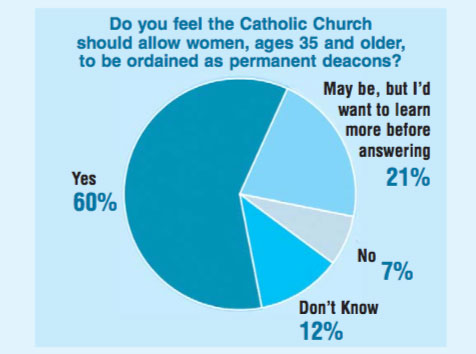 The survey indicates some evidence of an increase in interest in religious life among the youngest Catholic women. Thirteen percentage of those of the Millennial Generation considered being a religious sister or nun compared to 8% of the previous Post-Vatican II Generation.
The survey indicates some evidence of an increase in interest in religious life among the youngest Catholic women. Thirteen percentage of those of the Millennial Generation considered being a religious sister or nun compared to 8% of the previous Post-Vatican II Generation.
Overall, 2% of Catholic women have considered becoming a religious sister or nun “very seriously.” An additional 5% considered this “somewhat seriously.” Seven percentage of respondents either “somewhat” or “very” seriously considering a vocation is equivalent to 2.1 million women.
Around half of Catholic women say the priests in their parish “do a good job” of including women in various aspects of parish life. Respondents were most likely to say “yes, definitely” that priests in their parish do a good job of including women in the parish community (57%). Thirty-five percentage “somewhat” felt like priests do a good job at this. Only 8% said priests don’t do a good job of this. Fewer said “yes, definitely” that priests do a good job of including women on parish councils (50%), in lay ministry positions (49%), and in the decision-making of the parish (45%).
There are also some partisan differences. Women who self-identify as Republicans are more likely than others (those unaffiliated with a party and Democrats) to say the priests at their parish are definitely doing a good job including women in the parish community (67% compared to 53% of the politically unaffiliated and 55% of Democrats, respectively), on parish councils (60% compared to 48% and 47%, respectively), in lay ministry positions (58% compared to 46% and 46%, respectively), and in the decision-making of the parish (51% compared to 45% and 42% respectively).
In 2016 Pope Francis announced a commission to study the possibility of women serving as permanent deacons. Do you feel the Catholic Church should allow women, ages 35 and older, to be ordained as permanent deacons?
Six in ten Catholic women, after reading the description provided, responded “yes” that they supported the possibility for women, ages 35 and older, being ordained as permanent deacons (60%). One in five indicated that they may support this but want to learn more before answering (21%). Twelve percentage said they “didn’t know.” Only 7% said “no” that they would not support women being ordained as deacons.
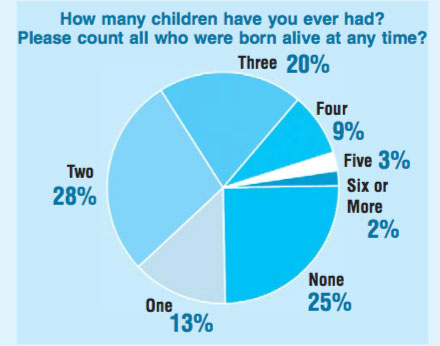 Women who self-identify as Democrats are more likely than Republicans or the politically unaffiliated to say, “yes” they support female deacons (65% compared to 57% of the unaffiliated and 55% of Republicans). Non-Hispanic white women are more likely than those self-identifying as Hispanic or Latino to support women being able to be ordained as deacons (66% compared to 50%).
Women who self-identify as Democrats are more likely than Republicans or the politically unaffiliated to say, “yes” they support female deacons (65% compared to 57% of the unaffiliated and 55% of Republicans). Non-Hispanic white women are more likely than those self-identifying as Hispanic or Latino to support women being able to be ordained as deacons (66% compared to 50%).
Only 18% of never-married Catholic women say it is “very much” important to them to marry someone who is Catholic. Twelve percent said they don’t plan to marry (2% of all adult Catholic women). About a third, 32%, of those who plan to marry in the future, said it is “very much” important to them to marry in the Catholic Church. A majority of these respondents said it is at least “somewhat” important to them (56%).
The typical Catholic woman in the United States has had two children and both of those children are Catholic. Most often, they grew up in households where they had three brothers or sisters. Thus, their parents often had twice as many children as they have had. For the typical Catholic woman, two of their three siblings remains Catholic as an adult. Today, only one in ten Catholic women has four children (9%) and 20% have three. Twenty-eight percent have two children, 13% have one, and 25% have none.
About a third of ever-married Catholic women (including those living with a partner) who attend Mass weekly have used NFP compared to 12% of those attending Mass a few times a year or less often. Hispanic respondents are more likely than non-Hispanic respondents to say they have used NFP (27% compared to 19%).
If respondents had used NFP, they were asked about their reasons for deciding to do so. The most common reasons cited were related to finances (38% “very important”), not wanting to have more children (34%), and their relationship with their husband (33%). Fewer indicated the following to be important: medical concerns (26%), time concerns (23%), or space concerns (20%).
Leave a Comment